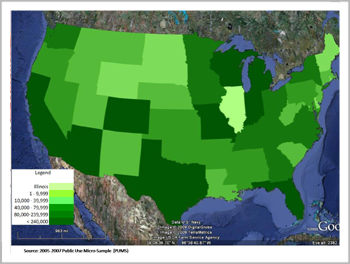By Kiljoong Kim
A little hole-in-the wall restaurant called Ginza, located on the 1st floor of Tokyo Hotel in downtown Chicago is a small haven for many weary Japanese salarymen visiting Chicago, a home away from home. The same sentiment can be found for Chicagoans at a Cubs bar named Lulu’s in Kona, or a Bears bar called Bruno’s in Fountain Hills, Arizona.
With a great deal of mobility for jobs and schools, many people no longer live in their places of birth. Though more than two-thirds (66.8%) of Illinois residents were born in the state, and it is unknown how many have moved overseas, more than 4.4 million Illinois natives have traveled afar and settled across the country. And these Illinois natives in other states show that moving isn’t simply about jobs and schools.

Top Ten States With Residents Born In Illinois
1. California: 482,441
2. Florida: 427,217
3. Indiana: 334,677
4. Wisconsin: 334,396
5. Texas: 299,573
6. Missouri: 243,306
7. Arizona: 241,992
8. Michigan: 170,740
9. Colorado: 133,612
10. Georgia: 129,488
According to the latest census data, more than half of Illinois natives (52.7%) are concentrated in seven states: California, Florida, Indiana, Wisconsin, Texas, Missouri, and Arizona. Aside from bordering states like Indiana, Wisconsin, and Missouri, where it is not surprising to have many Illinois natives, many seem to be drawn to the western part of the country by the warmer climate. Such gravitation toward mild weather becomes even more evident when we zoom into metropolitan areas, where the top 10 destinations for Illinois natives include Phoenix, Los Angeles, Tampa, Atlanta, Dallas, and Houston.
Top Ten Metro Areas With Residents Born In Illinois
1. Phoenix: 167,381
2. Gary-Hammond-East Chicago: 119,508
3. Los Angeles-Long Beach: 113,855
4. Tampa-St. Petersburg-Clearwater: 89,706
5. Atlanta: 87,957
6. Minneapolis-St. Paul: 82,253
7. Milwaukee: 75,900
8. Dallas-Fort Worth: 66,465
9. Indianapolis: 64,359
10. Houston-Brazoria: 63,414
Perhaps not so coincidentally, those Illinois natives concentrated in warmer states also tend to be older. For example, in California, where the median age is 34, the median age for Illinois natives residing in the state is 52. Similar figures are found in Arizona (34 versus 52) and Florida (39 versus 51).
Most Illinois residents living elsewhere are also white. In nine of the top 10 states with Illinois natives, more than 80% were white: 93.2% in Colorado; 93.1% in Arizona; 92.2% in Florida; 89.1% in Missouri; 84.4% in California; 83.1%in Wisconsin; 81.7% in Texas; 80.8% in Indiana; and 80.4% in Michigan.
The exception: Georgia, where 28% of Illinois-born residents are African American.
While these numbers suggest a large exodus of retiring or near-retirement population migrating to fairer weather, they also have taken affluence with them. Of the top 10 states, Wisconsin was the only state where Illinois natives earn lower total personal income than the overall population of the state ($21,729 for IL natives and $23,045 for the state). In California, Illinois natives have 65.4% higher median personal income than the overall population ($33,474 to $20,238) and 50.3% in Texas ($26,903 to $17,901). The less prosperous appear to be left behind.
These characteristics are quite different from the more than 4.2 million Illinois residents who were born in the other 49 states, District of Columbia, U.S. territories, and more than 140 other countries. Ilinois’s incoming population is younger (median age of 42), less affluent (median personal income of $21,660), and more diverse (fewer than 63% white).
Such disparities in characteristics provide a glimpse of what the future might look like in Illinois. Just as Irish and Italian immigrants and southern Blacks changed the composition of the state over a hundred years ago, and just as a massive number of Latino and Asian immigrants changed the region yet again after 1965, the entire Midwest is bound to experience another demographic shift.
* * *
Migration patterns for Illinois are very complex due to its demographic, economic, and racial/ethnic diversity. The state contains a very large metropolitan area that spills over to other states, while the rest of Illinois consists of small towns and farmlands. And as Chicago continues to globalize, it will increasingly attract people from different parts of the country and the world. During this process, those who leave the state also play a large role in becoming promoters of the state. While they may have left and taken their ability to pay taxes and spending habits with them, they retain their loyalty to their hometown sports teams and cuisine.
You can take the boy out of Illinois . . .
–
Kiljoong Kim is a research consultant and doctoral student in sociology at the University of Illinois at Chicago. He welcomes your comments. Read more in the the Who We Are archives.
Posted on May 20, 2009


